Can’t find the AppData folder? This MiniTool tutorial introduces two ways on how to find the AppData folder in the File Explorer or using Run. What if the AppData folder is missing or the files in it are lost? You can recover the files or this folder from Windows backup or using a professional data recovery tool.
What Is the AppData Folder?
Programs in Windows typically save their settings and temporary files within the AppData Folder. Each user account in Windows has its own dedicated AppData folder.
It’s typically located at C:\Users\username\AppData, where “username” is your Windows user account name.
By default, this folder is not visible in Windows File Explorer and consists of three hidden sub-folders: Local, LocalLow, and Roaming.
- The Local folder is designated for storing data that is unique to an individual Windows system, which means it does not synchronize across different PCs.
- The LocalLow folder serves a similar purpose to the Local folder, but it is intended for applications that operate with lower integrity and restricted security settings.
- The Roaming folder is meant for storing information that can be synchronized across various Windows systems. This folder is commonly used for saving settings like bookmarks, saved passwords, etc.
You may not access the AppData folder frequently, and might ask: Can I delete this folder or files in it?
Can I Delete the AppData Folder?
No, you should NOT delete the AppData folder or files in it on Windows.
Why should you not delete the AppData folder?
The AppData folder holds crucial data and configuration files for your applications and system. Deleting it can lead to:
- Applications may malfunction or lose their settings
- User profiles to revert to default
- Breakdown of system features
- Loss of data, such as browser profiles or game saves
What are your alternatives to free up disk space?
If you’re looking to free up space, you can safely delete or clean specific subdirectories:
# Way 1. Clear Temporary Files
- Press Win + R, type %temp%, and press Enter.
- Remove unnecessary files in the folder.
# Way 2. Use Disk Cleanup
- In the Start Menu, search for Disk Cleanup and run it.
- Choose your drive and select options like: Temporary files, Thumbnails, and System error memory dump files.
- Click the Clean up system files button.
Sometimes, you may encounter the AppData folder missing issue. What causes this error? Let’s take a closer look.
Why Is the AppData Folder Not Showing Up or Missing?
“I need to get to the AppData folder, but on my computer, when I go into C: drive per a link, AppData is not there or an option.”learn.microsoft.com
If the AppData folder is not visible or seems missing, it is probably because it is set to hidden by default on Windows.
You may wonder: Why does Windows hide the AppData folder?
The AppData folder contains important settings files and data for applications. Windows hides it to avoid unintentional deletion or changes that could disrupt apps or system performance.
So, how to get to the AppData folder? And if you can’t find AppData, how do you resolve it? Let’s find answers in the following part.
How to Find the AppData Folder
Need a quick guide? Watch this short video:
There are two feasible and simple ways to access the AppData folder quickly. You can access it by either manually browsing through File Explorer or by entering the %AppData% environment variable in the Run dialog.
Option 1. Use the Run Command
The fastest method to access the AppData folder in any Windows version is by using the Run dialog box.
Here’s how to use it to locate the AppData folder:
Step 1. Press Win + R to open the Run dialog window.
Step 2. Type %AppData% in the box and click OK or press Enter.
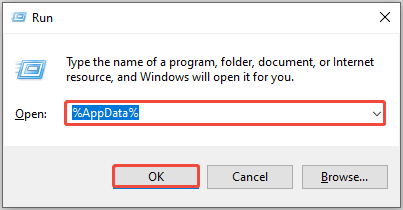
Step 3. File Explorer will open directly to the Roaming subfolder within AppData. To access the full AppData folder, click AppData in the File Explorer address bar to show all three subfolders in this location.
Option 2. Use the File Explorer
As the AppData folder is hidden, you may not be able to locate it. To view the AppData folder in the File Explorer, you need to make hidden items visible first.
Follow these instructions to learn how to access the AppData folder using File Explorer:
Process 1. Unhide the AppData folder.
There are two ways to unhide the AppData folder in the File Explorer Options and the File Explorer on Windows 11/10/8.1/8.
# 1. In the File Explorer Options:
- Type file explorer options in the taskbar search field and click Open to access it.
- Select the View tab and tick the box for Show hidden files, folders, and drives.
- Then click Apply > OK to save the changes.
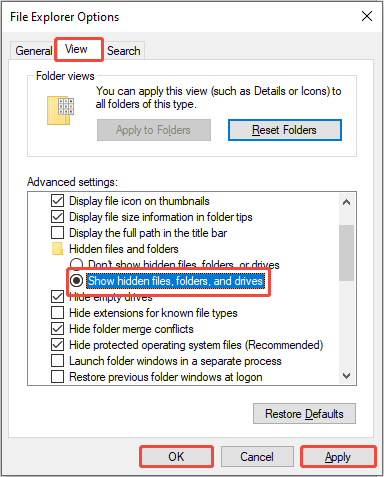
# 2. In the File Explorer:
Another way to unhide your AppData folder is directly using File Explorer. Follow these instructions to make AppData visible:
- Launch File Explorer and navigate to This PC.
- At the top of the screen, click on the View tab.
- From the drop-down menu, tick the Hidden items option.

The process to unhide the AppData folder in Windows 7 differs slightly from later versions. Here’s the way to do it on Windows 7:
- Click on Start to open the Control Panel.
- Choose Appearance and Personalization, then access Folder Options.
- Go to the View tab.
- Locate the option for Hidden files and folders and check the box next to Show hidden files, folders, or drives.
- Finally, click Apply and OK.
Process 2. Access the AppData folder in the File Explorer.
Step 1. Press Win + E together to open the File Explorer.
Step 2. Go to the Local Disk (C:) section, double-click the Users folder, and open your Windows account folder. Now, you can see the AppData folder.

Still can’t see the AppData folder? It may be due to the following reasons:
- User account problems: Issues with your Windows user account, like using a wrong or temporary user profile, can limit access to personal directories.
- File system damage: In rare instances, corruption of system files may render the AppData folder unreachable.
- Malware disruption: Certain types of malicious software can conceal or limit access to system directories.
- Unintentional deletion: Users might have accidentally removed the AppData folder.
- …
If you are encountering such an issue, keep reading to get your AppData folder back.
AppData Folder Missing: How to Get It Back
In this guide, we will introduce the most practical way to recover your lost AppData folder – use a professional data recovery software.
One effective tool for this purpose is MiniTool Power Data Recovery.
Why can you 100 % trust this software?
Below are some key features of this free data recovery software:
- Supports a variety of file formats: This all-encompassing data recovery tool aids in retrieving documents, photos, videos, audio files, emails, compressed files, and more.
- Compatible with multiple storage media types: This tool is compatible with HDDs, SSDs, SD cards, USB flash drives, and even CDs/DVDs.
- Includes file preview functionality: You can preview images, documents, videos, audio files, and other file types for free before you decide what to recover.
- Provides 1 GB of free data recovery limit: You can restore up to 1 GB of files at no cost.
Even if you’re not experienced with computers, MiniTool provides a user-friendly interface and a simple recovery process.
Download and install this MiniTool data restoration tool by clicking the button below.
MiniTool Power Data Recovery FreeClick to Download100%Clean & Safe
Use MiniTool Power Data Recovery to Restore the Lost AppData Folder
Here’s how to recover the AppData folder using MiniTool Power Data Recovery.
Step 1. Launch the MiniTool data recovery tool. On its main page, you will locate the Logical Drives tab. By default, the AppData folder is stored in the C drive. Therefore, you can select the C drive partition and click Scan.
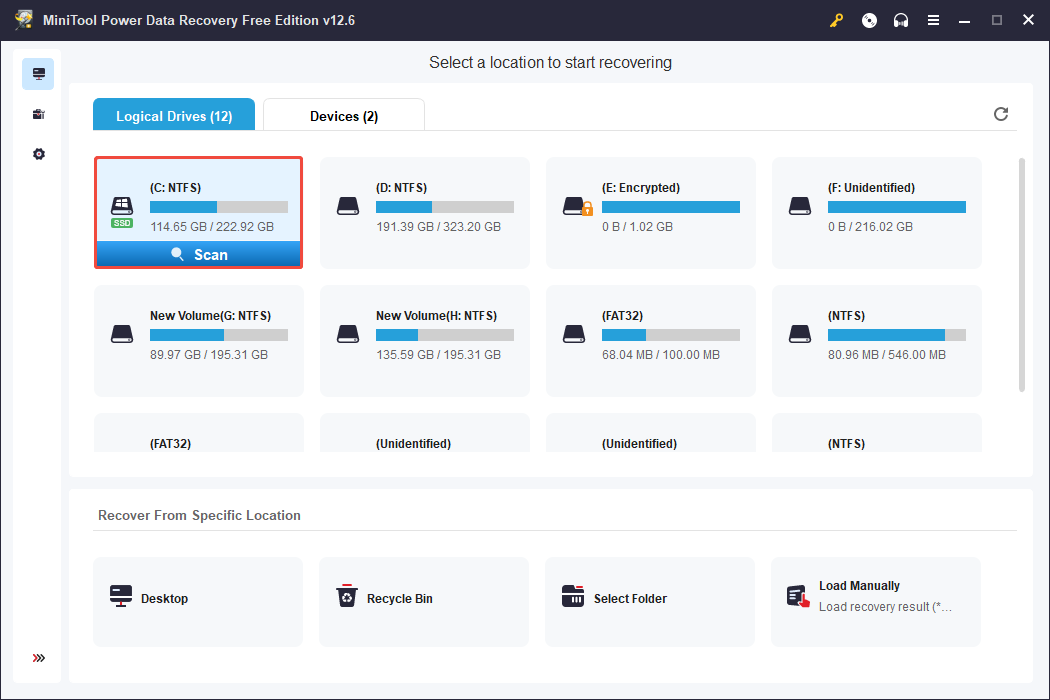
Since the C drive typically contains a large amount of data, the scan may take some time to complete.
To get a full scan result, it is recommended to wait for the scanning process to complete.
Step 2. Once the scan is complete, you will locate the Path tab. In this section, you can expand the Deleted Files, Lost Files, and Existing Files folders with an original file structure to find your AppData folder.
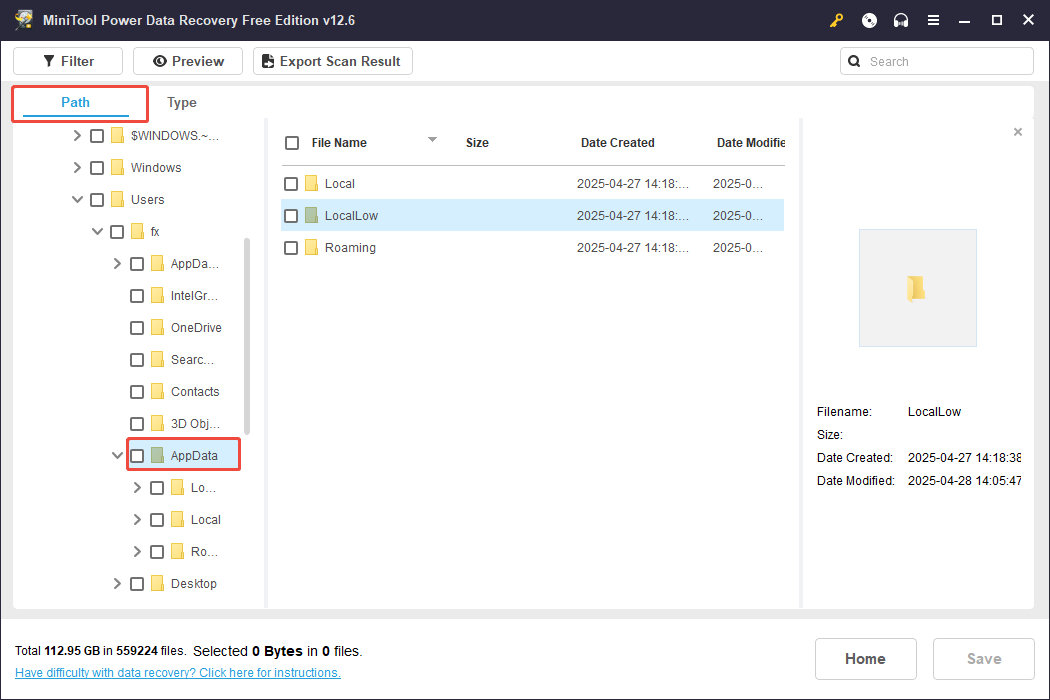
Additionally, you can use the Search feature to locate wanted files. To find the AppData folder, type AppData in the search box on the top-right corner and press Enter.
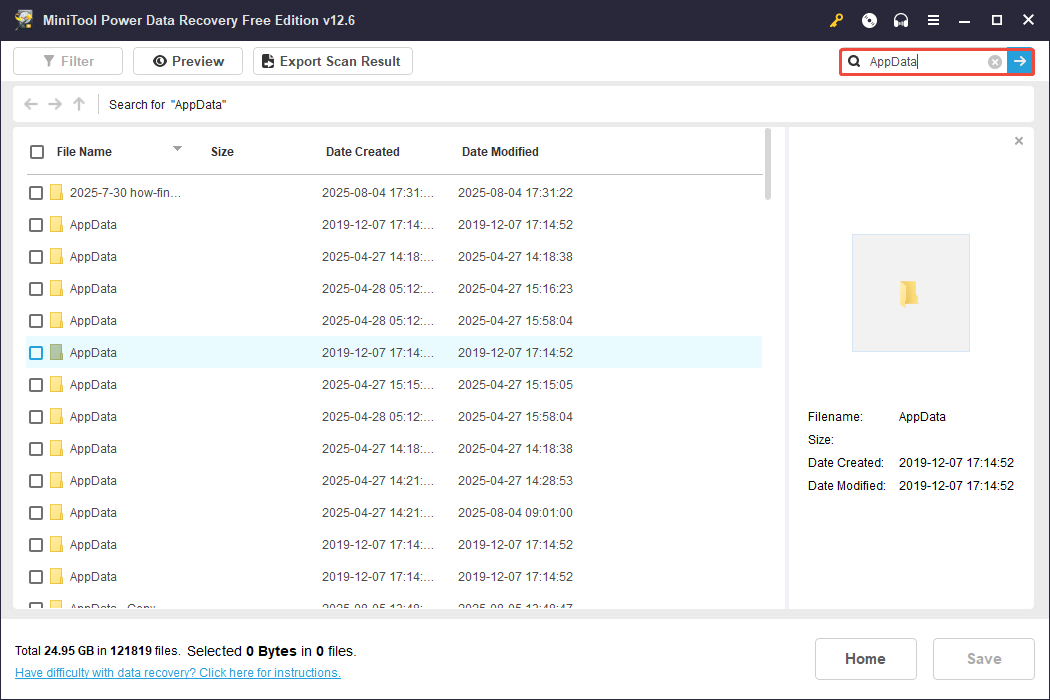
Step 3. Tick the AppData folder and click the Save button. In the pop-up window, you need to choose a different and safe file location to save the recovered folder to avoid data overwriting. Click OK to confirm the action.
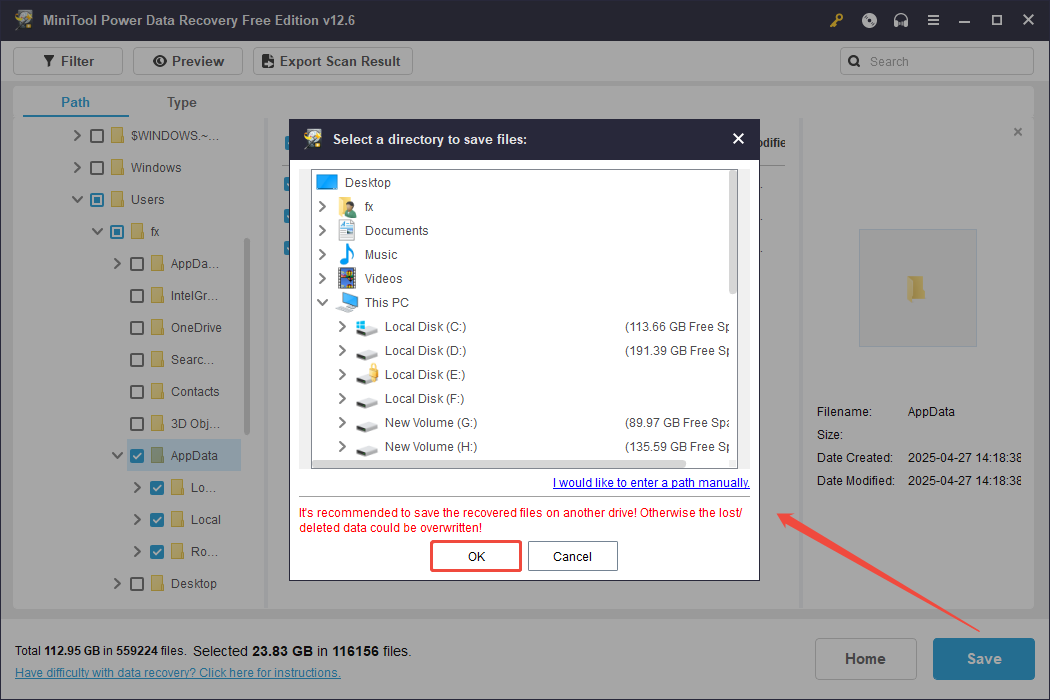
Most of the time, the size of the AppData folder is more than 1GB. To recover the whole AppData folder, you can opt for upgrading to the advanced version of MiniTool Power Data Recovery.
What If the Files in the AppData Folder Are Lost?
Files in the AppData folder may be lost due to accidental deletion, application uninstallation or update, or Windows reset or reinstall.
In this situation, you can first check whether the logged-in Windows account is correct. Then, consider recovering lost AppData files from backups or using MiniTool Power Data Recovery.
Fix 1. Make Sure You Are Logged into the Correct Windows Account
If someone previously used a different account and forgot to log out, or if your computer has undergone a recent upgrade that automatically creates a new user account, your AppData files may be lost in Windows. To resolve this issue:
Step 1. Click on the Start button found in the bottom-left corner.
Step 2. In the upper-left area of the Start menu, select your username. Then, sign out and log in again using your main account.
Step 3. Enter your password to access your main profile. Once logged in, check if any files that were previously missing from the desktop have reappeared.
Fix 2. Restore the Previous Version
Windows has a built-in backup feature called File History, which allows you to restore earlier versions of files. Make sure you have enabled the File History and choose to back up the AppData files. Here’s how to recover AppData files using File History.
Step 1. Open File Explorer, navigate to This PC > Local Disk (C:) > Users > username. Locate and right-click the AppData folder and select Restore previous versions.
Step 2. In the pop-up window, choose a folder version where your files are not lost or deleted and click the Restore button.
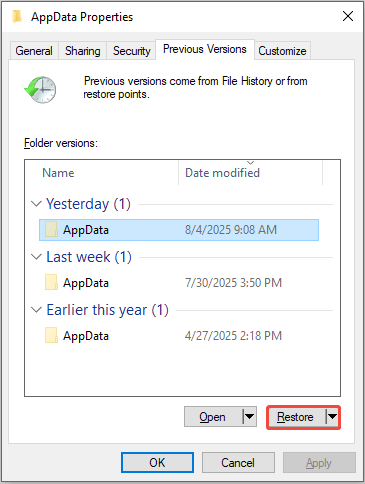
Step 3. Next, click Restore to confirm the action.
Fix 3. Use MiniTool Power Data Recovery
If the above two methods failed to get your AppData files back, you can use MiniTool Power Data Recovery – a robust data recovery tool to carry out lost file recovery.
The detailed information about MiniTool Power Data Recovery is mentioned above. With this free data recovery tool at hand, you can easily rescue your AppData files on Windows.
MiniTool Power Data Recovery FreeClick to Download100%Clean & Safe
Now, you can follow these steps below to recover lost or deleted AppData files.
Step 1. Launch MiniTool Power Data Recovery. On the main interface, locate the target partition where lost AppData files are stored under Logical Drives. Then, select it and click the Scan button to start scanning.
Step 2. After the full scan has been completed, you can begin searching for the files you wish to recover.
By default, you can expand the folders and subfolders under Path to locate and select the files or folders you want to restore.
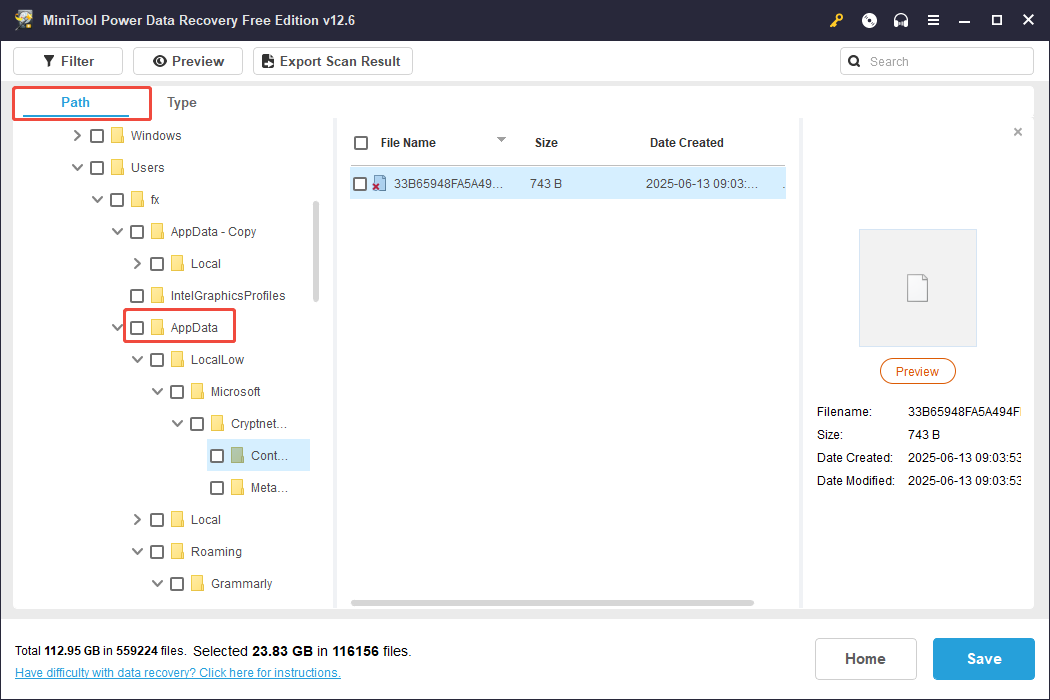
Alternatively, you can navigate to the Type tab to view and find the desired files based on their file type.
Additionally, the Filter feature can help refine the file list further. Click on Filter and establish the filtering parameters using file type, date modified, file size, and file category.
Want to find a specific file? You can type that partial or whole name in the search box and press Enter.

Step 3. Once you have ticked all the files you want to recover, click the Save button. In the new window, select a different location that has sufficient free space to accommodate the restored files.
Wrap Up
How to find the AppData folder? You can try the two workarounds: Use the Run command and manually navigate to the folder in the File Explorer after unhiding it.
If you still can’t find the AppData folder after unhiding it, do not worry. I introduce a robust data recovery tool to help you get it back.
Encountering data loss in AppData? You need to carefully check your logged-in Windows account and Windows backup. If no one succeeds, give MiniTool Power Data Recovery a shot.
Should you have any questions or encounter issues while using MiniTool Power Data Recovery, feel free to contact our support team at [email protected].
User Comments :